
(a)
Interpretation:
IUPAC name for the acrylic acid has to be given.
Concept Introduction:
For naming a
IUPAC rules for naming a carboxylic acid:
- The longest parent carbon chain is identified that includes the carboxyl group.
- The parent chain name is changed by replacing the suffix “-e” with “-oic acid”.
- Numbering is done in a way that the carboxyl group is designated as number 1. This is not indicated in the part of the name because for
aldehyde , the carboxyl carbon is always numbered 1. - The identity and location of substituents if any has to be determined and this information has to be added in front of the IUPAC name.
- If the carboxyl
functional group is attached to a ring of carbon atoms, the ring is named and “-carboxylic acid” is added as suffix. - If the compound contains two carboxyl groups, then suffix “-dioic acid” is added after the parent alkane name.
(a)
Answer to Problem 16.33EP
IUPAC name of acrylic acid is propenoic acid.
Explanation of Solution
Structure of acrylic acid is,
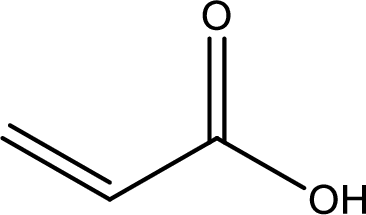
The longest continuous carbon chain has to be found out with the carboxyl group in it. In this it is a three carbon chain. The structure contains a double bond between carbon atoms. Hence, the parent is propene. The given structure contains a carboxyl group. The carboxylic acid is named by replacing the suffix “-e” with suffix “-oic acid”. This gives the name of carboxylic acid as propenoic acid.

Looking for substituents it is found that there are no substituents present on the carbon chain. Hence, the IUPAC name of the acrylic acid is propenoic acid.

IUPAC name of acrylic acid is given.
(b)
Interpretation:
IUPAC name for the lactic acid has to be given.
Concept Introduction:
For naming a carboxylic acid in IUPAC nomenclature, the suffix “-oic” is added to the parent alkane name.
IUPAC rules for naming a carboxylic acid:
- The longest parent carbon chain is identified that includes the carboxyl group.
- The parent chain name is changed by replacing the suffix “-e” with “-oic acid”.
- Numbering is done in a way that the carboxyl group is designated as number 1. This is not indicated in the part of the name because for aldehyde, the carboxyl carbon is always numbered 1.
- The identity and location of substituents if any has to be determined and this information has to be added in front of the IUPAC name.
- If the carboxyl functional group is attached to a ring of carbon atoms, the ring is named and “-carboxylic acid” is added as suffix.
- If the compound contains two carboxyl groups, then suffix “-dioic acid” is added after the parent alkane name.
(b)
Answer to Problem 16.33EP
IUPAC name of lactic acid is 2-hydroxypropanoic acid.
Explanation of Solution
Structure of lactic acid is,

The longest continuous carbon chain has to be found out with the carboxyl group in it. In this it is a three carbon chain. The parent alkane is propane. The given structure contains a carboxyl group. The carboxylic acid is named by replacing the suffix “-e” with suffix “-oic acid”. This gives the name of carboxylic acid as propanoic acid.
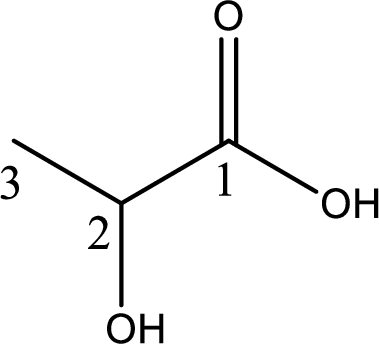
Looking for substituents it is found that there is a hydroxyl group at the second carbon atom. Hence, the IUPAC name of the lactic acid is 2-hydroxypropanoic acid.
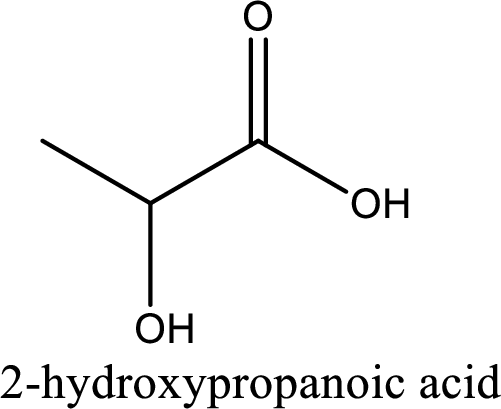
IUPAC name of lactic acid is given.
(c)
Interpretation:
IUPAC name for the maleic acid has to be given.
Concept Introduction:
For naming a carboxylic acid in IUPAC nomenclature, the suffix “-oic” is added to the parent alkane name.
IUPAC rules for naming a carboxylic acid:
- The longest parent carbon chain is identified that includes the carboxyl group.
- The parent chain name is changed by replacing the suffix “-e” with “-oic acid”.
- Numbering is done in a way that the carboxyl group is designated as number 1. This is not indicated in the part of the name because for aldehyde, the carboxyl carbon is always numbered 1.
- The identity and location of substituents if any has to be determined and this information has to be added in front of the IUPAC name.
- If the carboxyl functional group is attached to a ring of carbon atoms, the ring is named and “-carboxylic acid” is added as suffix.
- If the compound contains two carboxyl groups, then suffix “-dioic acid” is added after the parent alkane name.
(c)
Answer to Problem 16.33EP
IUPAC name of maleic acid is cis-butenedioic acid.
Explanation of Solution
Structure of maleic acid is,
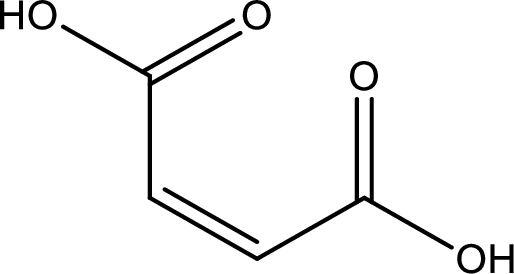
The longest continuous carbon chain has to be found out with the carboxyl group in it. In this it is a four carbon chain. The structure contains a double bond in it. The parent carbon chain is butene. The given structure contains two carboxyl groups. The carboxylic acid is named by adding suffix “-dioic acid”. This gives the name of carboxylic acid as butenedioic acid.
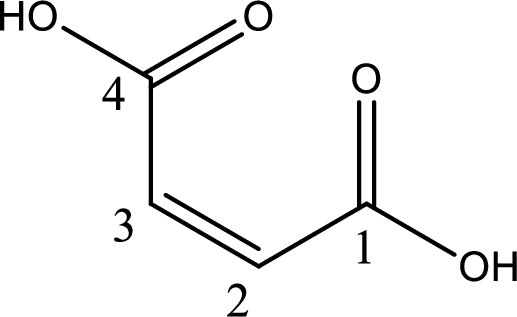
Looking for substituents it is found that there are no substituents present in the carbon chain. Stereochemistry is possible across the double bond. As the two hydrogen atoms are on the same side of double bond, the configuration at the double bond is “cis”. This has to be included in the name to get the IUPAC name. IUPAC name of the maleic acid is found as cis-butenedioic acid.

IUPAC name of maleic acid is given.
(d)
Interpretation:
IUPAC name for the glycolic acid has to be given.
Concept Introduction:
For naming a carboxylic acid in IUPAC nomenclature, the suffix “-oic” is added to the parent alkane name.
IUPAC rules for naming a carboxylic acid:
- The longest parent carbon chain is identified that includes the carboxyl group.
- The parent chain name is changed by replacing the suffix “-e” with “-oic acid”.
- Numbering is done in a way that the carboxyl group is designated as number 1. This is not indicated in the part of the name because for aldehyde, the carboxyl carbon is always numbered 1.
- The identity and location of substituents if any has to be determined and this information has to be added in front of the IUPAC name.
- If the carboxyl functional group is attached to a ring of carbon atoms, the ring is named and “-carboxylic acid” is added as suffix.
- If the compound contains two carboxyl groups, then suffix “-dioic acid” is added after the parent alkane name.
(d)
Answer to Problem 16.33EP
IUPAC name of glycolic acid is 2-hydroxyethanoic acid.
Explanation of Solution
Structure of glycolic acid is,
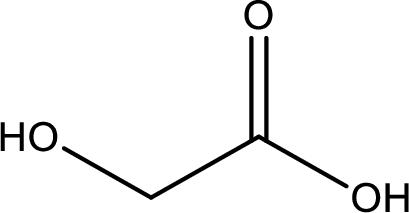
The longest continuous carbon chain has to be found out with the carboxyl group in it. In this it is a two carbon chain. The parent alkane is ethane. The given structure contains a carboxyl group. The carboxylic acid is named by replacing the suffix “-e” with suffix “-oic acid”. This gives the name of carboxylic acid as ethanoic acid.

Looking for substituents it is found that there is a hydroxyl group at the second carbon atom. Hence, the IUPAC name of the glycolic acid is 2-hydroxyethanoic acid.
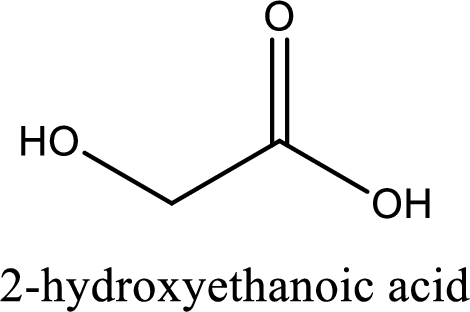
IUPAC name of glycolic acid is given.
Want to see more full solutions like this?
Chapter 16 Solutions
EBK GENERAL, ORGANIC, AND BIOLOGICAL CH
- Name a naturally occurring carbohydrate and its source for each type of carbohydrate listed in Problem 20.83.arrow_forwardFumaric acid is a metabolic intermediate that has the systematic name trans-2-butenedioic acid. Draw its structure.arrow_forwardPotentiometric titration curve is given below, which is obtained during the potentiometric titration between strong base KOH (0.2 M) with strong acid HI, label the point in the curve from the following options. If more than one points are present than write as x, y(means separate by using comma) a)The point where pH is because of excess OH - ions. b) The point where pH is only because of HI in water. c)The point where [HI]= [I] in water. d)The point where pH=pka e) The point where all HI is neutralized. f) The point where pH corresponds to solution of [I- ] in water. 14 13 12 11 10 9 pH 6. TITIT TITarrow_forward
- What is isopropylthiogalactoside (IPTG) ?arrow_forwardDraw the structure of the PTH derivative product you would obtain by Edman degradation of the following peptides: (a) I-L-P-F (b) D-T-S-G-Aarrow_forwardThe structure of ephedrine isgiven, The pKa for ephedrine is 9.6. Answer the following questions about aqueous solutions of ephedrine. a. Draw the structure of the principal chemical form of ephedrine that results when it isdissolved in water.b. Draw the structure of the principal chemical form of ephedrine that results when it is dissolved in a buffer at a physiologically relevant pH of 7.4.c. Calculate the pH that results when 0.3 mole of ephedrine is dissolve in 2.0 L of 0.05 M perchloric acid (HClO4).arrow_forward
- Give one specific sample structure (Fischer Projection or Haworth) of the following carbohydrate derivatives: - Amino-sugararrow_forward11.96 Is there a crude association between either measure of adiposity (BMI, WHR), considered separately, and serum estradiol?arrow_forwardDraw the structure of: a. 1-palmitoleyl-2-linolenyl-3-stearyltriglyceride. b. 1-linolenyl-2-arachidyl-3-phosphatidylserine.arrow_forward
- 49.10 Lactic Acid Salicylic Acid 48 5 g 2g Trichloroacetic Acid Flexible Collodion q.s. ad 100 g Sig: wart remover. Use as directed. (a) Flexible collodion contains 20% w/w camphor and 30% w/w castor oil. How many grams of each would be contained in 30 g of the mixture? (b) The specific gravity of castor oil is 0.955. How many milliliters of the oil are contained in 30 g of the mixture? (c) If the specific gravity of the mix- ture is 0.781, what are the w/v con- centrations of lactic acid, salicylic acid, and trichloroacetic acid in the mixture? 49. (a) 5.34 g camphor and 8.01 g castor oil (b) 8.39 mL castor oil (c) 3.12% w/v lactic acid, 3.91% w/v sali- cylic acid, and 1.56% w/v trichloroacetic acidarrow_forwardCocaine (C17H21O4N; Figure 2) is a natural substance found in leaves of the coca plant, which have been used for centuries as a local anaesthetic and stimulant. Illegal cocaine arrives in the USA either as the pure compound or as the hydrochloride salt (C17H21O4NHCl). At 25oC, the salt is very soluble in water (2.50 kg/L), but pure cocaine is much less so (1.70 g/L)What is the maximum amount of the salt (in gram) that can dissolve in 50.0 mL of water?When a 25 mL aqueous solution that contains 62.50 g of the salt is treated with NaOH, the salt is converted to pure cocaine. How much water (in litres) is needed additionally to dissolve the formed pure cocaine?arrow_forwardThe ionization of p-nitrophenol is shown below (pKa = 7.0): a. Identify the weak acid and conjugate base. b. At pH 7, what are the relative concentrations of ionized and un-ionized p-nitrophenol? c. If enough concentrated hydrochloric acid is added to a solution of p-nitrophenol to lower the pH from 7 to 5, what will happen to the relative concentrations of the ionized and un-ionized forms? d. Ionized p-nitrophenol has a yellow color, while the un-ionized form is colorless. The yellow color can be measured using a spectrophotometer at 400nm. In order to determine the total amount of p-nitrophenol in a solution, would you perform the spectrophotometer reading at an acidic or basic pH? Clearly explain why? e. A solution of p-nitrophenol at pH 7.95 was found to have an A400 of 0.255 . What is the total concentration (in µM) of p-nitrophenol (ionized plus un-ionized) in the solution? The molar extinction coefficient of p-nitrophenol is 18,500 M-1cm-1 and the pKa is 7.arrow_forward
 Human Anatomy & Physiology (11th Edition)BiologyISBN:9780134580999Author:Elaine N. Marieb, Katja N. HoehnPublisher:PEARSON
Human Anatomy & Physiology (11th Edition)BiologyISBN:9780134580999Author:Elaine N. Marieb, Katja N. HoehnPublisher:PEARSON Biology 2eBiologyISBN:9781947172517Author:Matthew Douglas, Jung Choi, Mary Ann ClarkPublisher:OpenStax
Biology 2eBiologyISBN:9781947172517Author:Matthew Douglas, Jung Choi, Mary Ann ClarkPublisher:OpenStax Anatomy & PhysiologyBiologyISBN:9781259398629Author:McKinley, Michael P., O'loughlin, Valerie Dean, Bidle, Theresa StouterPublisher:Mcgraw Hill Education,
Anatomy & PhysiologyBiologyISBN:9781259398629Author:McKinley, Michael P., O'loughlin, Valerie Dean, Bidle, Theresa StouterPublisher:Mcgraw Hill Education, Molecular Biology of the Cell (Sixth Edition)BiologyISBN:9780815344322Author:Bruce Alberts, Alexander D. Johnson, Julian Lewis, David Morgan, Martin Raff, Keith Roberts, Peter WalterPublisher:W. W. Norton & Company
Molecular Biology of the Cell (Sixth Edition)BiologyISBN:9780815344322Author:Bruce Alberts, Alexander D. Johnson, Julian Lewis, David Morgan, Martin Raff, Keith Roberts, Peter WalterPublisher:W. W. Norton & Company Laboratory Manual For Human Anatomy & PhysiologyBiologyISBN:9781260159363Author:Martin, Terry R., Prentice-craver, CynthiaPublisher:McGraw-Hill Publishing Co.
Laboratory Manual For Human Anatomy & PhysiologyBiologyISBN:9781260159363Author:Martin, Terry R., Prentice-craver, CynthiaPublisher:McGraw-Hill Publishing Co. Inquiry Into Life (16th Edition)BiologyISBN:9781260231700Author:Sylvia S. Mader, Michael WindelspechtPublisher:McGraw Hill Education
Inquiry Into Life (16th Edition)BiologyISBN:9781260231700Author:Sylvia S. Mader, Michael WindelspechtPublisher:McGraw Hill Education





